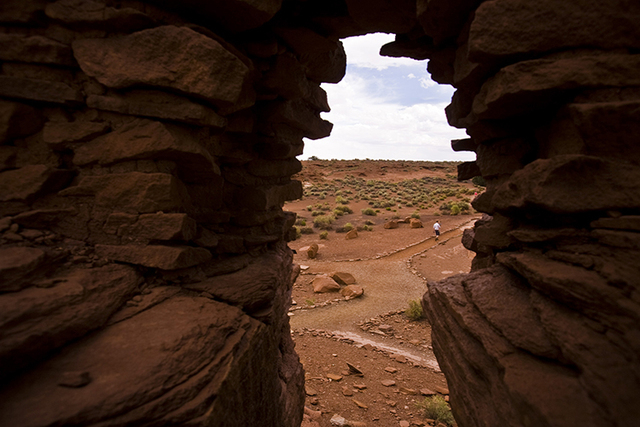Explore ancient cultures near Flagstaff
Visitors to Flagstaff, Ariz., can learn about native cultures at the Museum of Northern Arizona and see glimpses of the region’s fascinating past on scenic side trips to three nearby national monuments.
Walnut Canyon, Wupatki and Sunset Crater Volcano — managed collectively by the National Park Service as Flagstaff Area National Monuments — are open to visitors year-round, except Christmas Day.
Flagstaff is about a five-hour drive from Las Vegas using U.S. Highway 93 to Kingman, Ariz., and Interstate 40 east to Flagstaff. The museum is about three miles from downtown, at 3101 N. Fort Valley Road. Cliff dwellings in Walnut Canyon are about 10 miles from the center of town using I-40 east. Access the ruins at Wupatki and nearby Sunset Crater on a 36-mile loop road off U.S. Highway 89 beginning 12 miles from Flagstaff.
The Museum of Northern Arizona provides an overview of ancient culture in the region. For hundreds of years, ancient nomadic people passed through the area on hunting and gathering forays before other cultures came there to stay.
Arriving about A.D. 600, the first permanent inhabitants stayed until about 1400. They built a variety of dwellings depending upon the sites they selected, including multi-storied towers, pit houses and cliff dwellings. They cultivated small plots of corn, beans and squash, sometimes practicing dry farming or cleverly utilizing water from small springs, seeps and run-off. Scientists dubbed them the Sinagua, Spanish for “without water.”
Artifacts from their villages reveal far-flung connections to other cultures through extensive trading of items such as pottery, shells from the Pacific Ocean and the Gulf of Mexico, copper bells from Mexico and macaws from Central and South America.
Varied museum exhibits concentrate on archaeology, anthropology, ethnology and geology related to regional native people past and present. The facility preserves and interprets artifacts from early cultures, as well as featuring fine arts and crafts created by modern-day Native Americans. The museum is open daily, except holidays.
The Sinagua of Walnut Canyon took advantage of the canyon’s 400-foot walls, building hundreds of single-story rooms into ledges in the cliffs, as well as constructing pit house and above-ground structures near their crops on the plateau above the canyon. The community developed over a span of about 130 years beginning around A.D. 1120. The group had the advantage of a creek in the bottom of the canyon, as well seeps in the cliffs for domestic water.
Huge windows in the visitor center overlook Walnut Canyon, where foliage now bears the bright colors of autumn. A rim trail provides a short tour of ruins near the canyon, while a more challenging trail descends into the canyon 185 feet for a close look at the dark little rooms in the cliffs. Repairs underway on this trail may close parts of it. Walnut Canyon National Monument is open from 8 or 9 a.m. to 5 p.m., depending on the season. A small entrance fee applies.
To visit Wupatki and Sunset Crater Volcano, return to I-40, watching for the U.S. 89 exit north toward Cameron and Page. Turn onto the scenic loop road and drive two miles to the Sunset Crater visitor center. Entrance fees cover both national monuments. The thousand-foot crater is the result of an eruption in 1065, followed by about 40 years of volcanic unrest.
Follow the scenic loop road with its varied panoramas to visit some of the hundreds of ruins at Wupatki National Monument.
The Sinagua fled the volcanic fury that spewed rocks, lava and ash over the region. When they dared to return, they found their pit houses buried and their towers filled with ash. However, the farmers also found that the ash enriched the soil and helped retain precious water.
A trail from the visitor center leads to Wupatki Pueblo, a 100-room, multi-storied tower built of fitted, mortared sandstone. From noon to 4 p.m. Saturday, the structure will be the focus of a local observation of International Archaeology Day.
Margo Bartlett Pesek’s Trip of the Week column appears on Sundays.






















